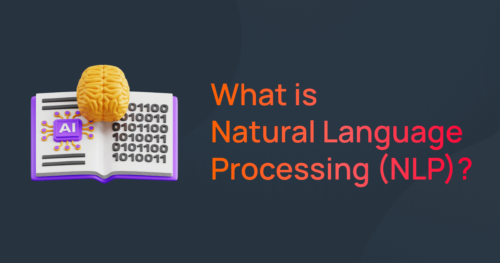What is NLP? Natural Language Processing Explained
NLP stands for natural language processing is a branch of artificial intelligence (AI) that enables machines to understand, interpret, and generate human language, written and spoken. By combining computational linguistics with machine learning and deep learning, NLP allows computers to analyse text and speech in the same way humans do.
From chatbots and virtual assistants to search engines and sentiment analysis tools, NLP is at the heart of many modern applications. As organisations go all in on AI, NLP is changing how we interact with technology, automate processes, and extract insights from unstructured data.
Natural Language Processing and the Rise of Machine Learning
Machine learning started to take off in NLP, which provided a way to analyse and understand human and spoken language more efficiently. Scientists started to train machines with different models, like statistical models such as Hidden Markov Models and Conditional Random Fields, to identify patterns in language data.
Improvements in machine learning algorithms allowed algorithms to better understand complex and ambiguous human language, and therefore, more types of data could be analysed effectively.
Research in machine learning algorithms led to the development of Support Vector Machines in the early 2000s. This improved speech recognition and text classification tasks significantly. All of these laid the ground for applying NLP for customer sentiment, natural language generation NLG, and machine translation in different industries.
How Deep Learning Revolutionized NLP
Deep learning has changed NLP. Learning algorithms like Recurrent Neural Networks and Convolutional Neural Networks have improved language processing tasks a lot. Machines can now understand the context and meaning of language and generate human like responses.
Learning has also given birth to language models like Gimini and GPT-4 that can understand and generate human language at a level never seen before. These models have opened up new applications of NLP like conversational AI, AI Agents, Agentic AI systems automated writing tools.
Foundation Models and LLMs in NLP
Foundation models like GPT, PaLM, LLaMA, and Claude are big neural networks trained on many different datasets for many different language tasks. Built on the transformer architecture, they can be fine-tuned for specific use cases like chatbots, search, and content generation.
Large Language Models (LLMs), a subset of foundation models, are great at generating context aware text. With self-supervised learning and retrieval-augmented generation (RAG), they are pushing the boundaries of human machine communication.
Self-Supervised Learning (SSL) in NLP
Self-supervised learning (SSL) is a game changing technique in NLP that allows models to learn from unlabeled text by generating their own training data. Instead of relying on expensive human annotations, SSL trains models to predict parts of the input data, like missing words in a sentence, making it perfect for building large language models.
SSL has been key to the development of advanced NLP systems like BERT and GPT-3, which use huge unlabeled corpora to achieve high performance across many tasks.
NLP Techniques and Methods
NLP uses many techniques to get machines to understand human language. A typical NLP pipeline has tasks like tokenization, part-of-speech tagging, named entity recognition, and parsing to analyze and generate human text.
Statistical and Machine Learning Models
NLP is a big and complex field of computer science to get machines to understand humans. The techniques and methods used to do this are many and evolving. Machine learning models learn from processed data and get better through ongoing evaluation and fine-tuning LLMs, and can make predictions on new data. Here we will look at some of the most common methods used in NLP projects.
Statistical models are used in natural language processing to analyze and understand structured and semi-structured data. They find patterns, trends, and correlations in data by applying statistical techniques. Statistical NLP uses machine learning to systematically analyze and classify text and voice data.
Examples of statistical models in NLP are Information Retrieval models, Probabilistic Context-Free Grammars (PCFGs), Hidden Markov Models (HMMs), and Conditional Random Fields (CRFs).
Rule-based Approaches
Rule-based systems use pre-defined if-then rules and linguistic logic to interpret text. Good for simple patterns, but not flexible and not scalable for natural language.

What are NLP Tools and Applications
NLP is enabled through various tools and approaches. This section explores some of the most commonly used ones in the industry.
NLP Software Libraries and Frameworks
The Natural Language Toolkit (NLTK) is a set of libraries and tools for English language processing in Python. It has text classification, tokenization, stemming, tagging, parsing, and AI reasoning functionality so you can train machine learning models for NLP tasks.
| Library/Framework | Description |
| NLTK | An open-source NLP library that provides a range of tools and resources for NLP, including corpora, lexical resources, and algorithms for text processing. |
| spaCy | A Python-based NLP library that contains pre-built models for various NLP tasks, including named entity recognition, part-of-speech tagging, and dependency parsing. |
| Stanford CoreNLP | A suite of natural language analysis tools that provides models for tokenization, part-of-speech tagging, named entity recognition, and sentiment analysis, among others. |
Programming Languages for NLP Applications
You can use many programming languages for NLP, but some are better than others. Python is the most popular language for NLP because it can handle data well and has many NLP libraries and frameworks.
NLP APIs and Platforms
NLP APIs and platforms give you access to pre-built NLP models and tools, often through cloud-based systems. These are useful if you want to add NLP to your application quickly and with minimal effort. Some of the popular NLP APIs and platforms are:
- Google Cloud Natural Language API
- Azure Text Analytics API
- Amazon Comprehend
Language translators are important in natural language processing and computational linguistics. Parsing techniques like dependency and constituency parsing are used in language translators and speech recognition to make machine outputs and human understanding more interpretable.
Using these tools and approaches, you can implement NLP more efficiently and build solutions that are faster, more accurate, and more effective.
Natural Language Understanding and Text Analysis
According to the AI glossary, Natural language understanding, NLU is a subfield of NLP that enables computers to understand humans the way humans understand. It involves the analysis of language models and various linguistic phenomena such as syntax, semantics, and pragmatics to capture the meaning and intent of natural language text.
NLU is a key component of text analysis in NLP. It’s about interpreting sentences so software can see similar meanings across different contexts and handle words with multiple meanings.
Text analysis, also known as text mining, is finding insights in unstructured text data. It’s applying various NLP techniques and methods to extract information, identify patterns, and reveal relationships in textual data.
Both NLU and text analysis are key components of natural language processing systems and are used in many applications. For example, in sentiment analysis, NLU is used to determine the sentiment of a piece of text and speech in most speech recognition software. It helps to better understand customer sentiment in AI customer service.
Text analysis is used to find the topics being discussed.
| NLU | Text Analysis |
| Example application: Chatbots that can understand and respond to natural language queries from users. | Example application: Identifying patterns and trends in customer feedback to improve products and services. |
| Key techniques: Named entity recognition, semantic role labeling, and machine translation. | Key techniques: Text categorization, topic modeling, and clustering. |
Information Retrieval
Information retrieval is a key natural language processing technique to extract information from large volumes of text data like documents, articles, or websites. This involves using machine learning algorithms and deep learning models to identify key elements like keywords, phrases, or entities.
A new development in this space is Retrieval-Augmented Generation (RAG), which combines traditional retrieval methods with language generation models. RAG improves response accuracy by fetching relevant data from external sources and feeding it into generative AI models like LLMs, so you get more factual and context-rich responses.
From powering search engines to enterprise knowledge bases, information retrieval helps businesses surface insights from unstructured data. Applied across sources like websites, social media, and internal documents, these techniques help users make informed decisions and improve operational efficiency.
Core NLP Tasks (Capabilities)
- Tokenization breaks down text into individual words, subwords, or sentences for easier analysis.
- Part-of-Speech Tagging (POS) assigns grammatical categories (e.g., noun, verb, adjective) to each word based on context.
- Named Entity Recognition (NER) identifies and classifies proper nouns in text into predefined categories like names, organizations, and locations.
- Dependency Parsing analyzes the grammatical structure of a sentence by mapping relationships between words. Syntactic structure helps to parse sentences and understand the grammatical rules governing language.
- Lemmatization reduces words to their base or dictionary form (lemma), considering the context.
- Stemming Cuts words down to their root form by removing suffixes, often without considering grammar or context.
- Coreference Resolution Detects when different expressions in a sentence refer to the same entity (e.g., “Bob” and “he”).
- Word Sense Disambiguation determines which meaning of a word is being used in a specific context.
- Sentiment Analysis evaluates the emotional tone behind a body of text as positive, negative, or neutral.
- Text Classification categorizes text into predefined groups or labels (e.g., spam vs. not spam).
- Machine Translation automatically converts text from one language to another while preserving meaning and tone.
- Text Summarization generates a shorter version of a text while preserving the key information.
- Speech Recognition (ASR) converts spoken language into written text using NLP and acoustic modeling.
- Natural Language Generation (NLG) automatically produces human-like text based on structured data or prompts.
- Topic Modeling identifies abstract topics within a collection of documents using statistical methods.
NLP Use Cases by Industry
NLP has many practical applications across many industries. Voice operated GPS systems are a great example of how NLP improves voice recognition to understand and process voice commands and make navigation more user-friendly. Here are some of the use cases:
1. Information Technology (IT)
NLP is used in IT teams to provide quick support to employees. This reduces the workload of IT service desk agents and improves employee satisfaction and productivity. Examples include automating software provisioning and approvals for employees, troubleshooting common IT issues, unlocking accounts and resetting passwords etc.
2. Human Resources (HR)
Using AI in HR is built on the NLP foundation. With the help of Natural Language Processing the HR department has achieved a lot of things, from hiring and firing to payroll and benefits. Examples include employee onboarding and offboarding, PTO management, benefits enrollment, proactive notifications and reminders and more.
3. Facilities
NLP is used to simplify tedious, manual, and repetitive tasks of facility management teams, from common office maintenance to employee work requests. This helps to improve collaboration across teams and departments like IT, HR, and Finance by automating workflows and processes.
Examples include a centralized facility and maintenance requests hub, proactive communication and updates, and more.
4. Customer Service & Support
NLP serves as the backbone of AI customer service to provide quick and efficient support to customers.
This reduces the workload of customer service agents and increases customer satisfaction. Example applications include customer sentiment analysis of customer feedback, intelligent routing of customer queries and personalized recommendations to customers, etc.
As key applications of NLP are in AI Copilots and AI assistants enabling businesses to provide 24/7 customer support, which improves customer experience.
5. Sales and Marketing
Leveraging NLP capabilities in sales & marketing to help with lead generation, lead routing to sales reps, help with pipeline analysis and forecasting. This reduces the friction in follow up from sales when the user is ready to talk to them and improves the buyer journey. Example applications include maximizing marketing ROI, generating more pipeline, automating renewals and upsell engagement etc.
Overall NLP is a powerful technology that has many practical applications across various industries and domains. Its ability to process and understand human language has changed the way we interact with computers and has given us insights from huge amount of textual data.
6. Education
NLP is used in language learning apps, automated essay scoring, intelligent tutoring systems and personalized feedback tools that adapt to students’ needs.
Machine learning and domain specific LLMs make NLP systems in education more powerful by allowing algorithms to better understand complex and ambiguous human language and therefore more data can be analyzed.
7. Finance
With millions of clinical notes, research articles, and patient data, natural language processing helps healthcare professionals get to the point faster. From summarizing patient histories to flagging potential diagnoses, natural language processing enables better decision-making and more personalized patient care.
8. Healthcare
With an overwhelming volume of clinical notes, research articles, and patient data, natural language processing enables healthcare professionals to surface critical insights faster. From summarizing patient histories to flagging potential diagnoses, natural language processing enhances decision-making and supports more personalized patient care.
9. Insurance
Natural language processing streamlines the insurance process by analyzing customer communications, claim forms, and policy documents. It detects inconsistencies, flags potential fraud, and automates repetitive tasks, reducing manual effort while improving accuracy and customer satisfaction.
Benefits of NLP
NLP can significantly improve productivity through automation and streamlining of various tasks. By automating repetitive and time-consuming tasks, such as data entry and analysis, employees can focus on higher-value tasks, leading to increased efficiency and productivity.
Machine learning methods enhance the capabilities of NLP systems by allowing algorithms to better interpret complex and ambiguous human language, thereby broadening the types of data that can be analyzed effectively.
Enhanced Decision-Making
NLP can extract insights from huge amounts of text data, so you can understand customer feedback, market trends, and other key factors. By using those insights, you can make better decisions and get better outcomes.
Actionable Insights from Text Data
NLP can analyze huge amounts of unstructured text data like customer feedback and social media posts to give you actionable insights. By understanding the sentiment and opinions behind the text, you can understand customer needs and preferences and get better products and services.
Efficient Data Management
NLP is used to extract and categorize data so you can manage huge amounts of text data. By extracting relevant information and categorizing it you can manage data better and make better decisions and outcomes.
Labeled data and AI annotation are important for training NLP models and AI accuracy, as they provide the context for the models to learn and make predictions.
Automated Translation (Multilingual Services)
NLP can facilitate the automated conversion of textual information, enabling businesses with multinational customers to expand their reach to a global audience on their own. Language translation is leveraging parsing techniques such as dependency and constituency parsing to enhance both machine outputs and human understanding.
By providing accurate and efficient translations of human languages, businesses can communicate with customers in their native language, leading to increased engagement and sales.
Accessibility
NLP makes accessibility by speech-to-text for people with hearing impairments and text-to-speech for users with visual impairments or reading difficulties, more inclusive digital experiences.
How NLP Models are Evaluated
LLM evaluation, or similarly evaluating NLP models, is essential to measure their performance and reliability. Common metrics include BLEU for machine translation, ROUGE for text summarization, and F1-score, precision, and recall for classification tasks. For language modeling, perplexity is used to assess how well a model predicts text. These metrics help developers fine-tune models and ensure quality across different NLP applications.

Challenges of Natural Language Processing
Despite major advancements, NLP still faces key challenges. Ambiguity and context sensitivity make it difficult for models to accurately interpret meaning, especially when words have multiple definitions or rely on subtle context. Variations in dialects, slang, and informal language further complicate model generalization.
From a data science viewpoint, training data quality, annotation bias, and model explainability remain critical concerns. Researchers continue to address risks such as hallucinations in generative models, misinterpreting sarcasm, prompt injection attacks, and lack of transparency in outputs. In summary, the challenges that NLPs are facing are:
- AI Hallucinations in generative models
- Misinterpretation of sarcasm/irony
- Adversarial inputs and prompt injection attacks
- Transparency and explainability issues
The Future of Natural Language Processing
The future of NLP in 2025 is all about foundation models, multimodal AI, and retrieval-augmented generation. Language systems are now more accurate, adaptive, and context aware – powering intelligent agents, copilots, and real-time decision support across industries.
As NLP evolves, ethical development is key. Responsible AI practices must guide how we train, deploy, and evaluate these systems to ensure fairness, privacy, and transparency at scale.
Multimodal NLP (Vision + Language)
The future of NLP is moving beyond text to include multimodal models that understand and generate language with images, audio, and video. Models like CLIP, Gemini, and GPT-4V combine vision and language to do tasks like image captioning, visual question answering, and context aware content generation. This is a big step towards more human-like AI that can interpret and respond to multiple forms of input.
Conclusion
Clearly, NLP has changed the way humans interact with computers and is behind the scenes of AI systems, including Agentic AI. NLP is an essential tool for many industries, from healthcare to customer service, social media analysis to finance. NLP is used to solve complex problems and extract valuable insights from massive amounts of text data. To experience the power of Aisera’s enterprise agentic AI, request a free AI demo today!

